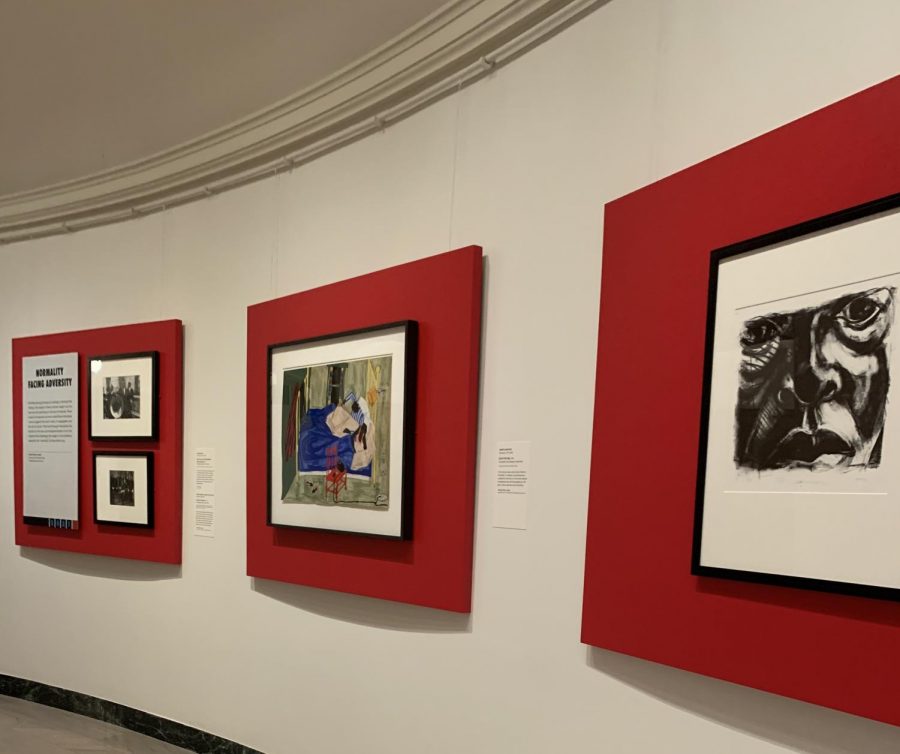Review: A year later, ‘Black Histories, Black Futures,’ exhibit is as relevant as ever
“Black Histories, Black Future” will be on display until June 20, 2021.
February 16, 2021
Walking into the Mary Stamas Gallery of the Museum of Fine Arts, or MFA, in Boston, you’re greeted by an etching of a giant head. Created by John Wilson in 2003, “Monumental Head” is a black and white etching of a side profile that draws viewers in with its intensity and high color contrast. It’s an enticing piece that serves as a warm welcome for the museum’s year-old exhibit.
Wilson’s piece is a part of the museum’s exhibit, “Black Histories, Black Futures,” created in honor of the museum’s 150-year anniversary celebration. Installed Jan. 20, 2020 during the museum’s celebration for Martin Luther King Jr. Day, the exhibit contains four themed sections curated by local teens: Jadon Smith’s “Ubuntu: I Am Because You Are,” Destiny Santiago-Mitchell’s “Welcome to the City,” Armani Rivas’ “Normality Facing Adversity” and Jennifer Rosa’s “Smile in the Dark.”
Despite being installed last year, the exhibit is as relevant as ever. Following the resurgence in calls for social justice and protests surrounding Black Lives Matter, it’s still important to raise up voices that have long been underrepresented. “Black Histories, Black Futures” not only gives the spotlight to Black artists, but it also gives the spotlight to the teens that put the exhibit together.
The exhibit lies at the center of the museum and spans over three different galleries – the Carol Vance Wall Rotunda, Jean S. and Frederic A. Sharf Visitor Center and Lower Hemicycle. It was created in partnership with local youth organizations focused on the empowerment of teens: Becoming a Man, the BASE and the Bloomberg Arts Internship Boston program. Teens in these organizations began their curations in the summer of 2019. In addition to the previously mentioned teen curators, Alejandro Flores and Jingsi Li took part in the curatorial workshops led by members of the MFA’s Learning and Community Engagement department. Members of the MFA’s Teen Arts Council also contributed to “Black Histories, Black Futures” by helping with curation and labeling.
The art displayed in the exhibit features prominent Black artists throughout the decades, and the curations of the local teens emphasizes their beauty and significance in Black history. Each section of the exhibit offers a new take on the art that is mainly part of the MFA’s John Axelrod Collection, including pieces from well-known artists like Norman Lewis as well as lesser-known artists like Napoleon Jones-Henderson. It’s clear that each piece of art was chosen with precision and care to best tell the story of “Black Histories, Black Futures.”
“Normality Facing Adversity” showcases the ‘normality’ of hardships Black individuals face in their daily lives. It also highlights the misrepresentation of Black lives in art and instead focuses on the ways these hardships are dealt with. Scenes of adolescence, such as boys at play, emphasize the normality they experienced despite these hardships. Photos of jazz icon Duke Ellington as well as other famous drummers show how music was an important aspect of life that brought joy and happiness to their everyday lives.
Rosa’s curation, “Smile in the Dark,” also focuses on the joy and hope in the Black community. According to the gallery’s label, “‘Smile in the Dark,’ gives viewers like you a small glimpse of what it was like to be unapologetically happy, during a time in which it was difficult to even let out a smirk.”
The exhibit certainly succeeds at that goal through its use of exuberant art. The pieces exude warmth, joy and hope, all evidenced in their content and depiction. For example, one display shows a series of photographs of a young African American woman wearing a bathing suit and lounging around happily. Another screenprint in the gallery by Napoleon Jones-Henderson features a colorful depiction of two Black men about to kiss, and according to the piece’s label, “Shows that even at times when people felt like the world was against them, they could still find love and happiness.”
The most centrally located section of the exhibit is “Ubuntu: I Am Because You Are.” Located in the Carol Vance Wall Rotunda, the exhibit features multiple large vibrant paintings by Black artists like Archibald Motley and Allan Rohan Crite. The colors of the paintings are what draw you in, but upon closer inspection, you see intricate and festive paintings of interpersonal connections and lively musical scenes. While artist Eldzier Cortor uses darker colors in his pieces, they are still scenes of intrigue and vitality that cause viewers to appreciate the artistry and message of the piece.
The vivacity of the art featured throughout the exhibit draws viewers in and causes them to appreciate the art for what it is. But what makes “Black Histories, Black Futures” particularly effective is not only the art that is proudly displayed on the walls of the museum, but the significance for what it could mean for the museum’s future. The partnership with local organizations and teens is an important way to showcase voices that are not often heard, and as explained by the gallery label in the Sharf Visitor Center, “The ideas, perspectives, and voices of these young scholars represent our commitment to the future, even as we celebrate the past.”
One can only hope that the museum continues to lift up underrepresented voices through partnerships with local organizations and curation of important thematic exhibits.
“Black Histories, Black Futures” will be available for viewing at the MFA until June 20, 2021.







